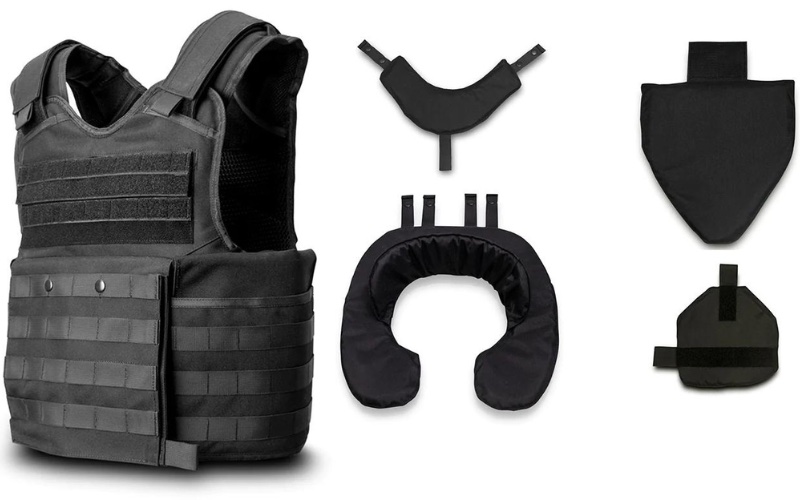The majority of us immediately picture bulletproof vests when someone mentions body armor. However, stab proof vest is also a popular type of protective clothing with a variety of uses.
First off, it’s crucial to recognize that Stab resistant armor and bulletproof armor are two entirely different things. Knife attacks cannot be thwarted by a normal bulletproof vest. It might be able to resist a few light stabbings and slashes, but attacks with spikes, homemade weapons, and needles cannot be stopped by them.
Stab vests are constructed of materials like Kevlar or Dyneema, which are resistant to attack by knives and other pointed items. These vests may even be a little thicker and are typically less flexible than ballistics vests. Police personnel choose to wear stab vests rather than bulletproof vests in several nations, such as the UK, where firearms are less prevalent. Since knife attacks are significantly more common than gunfire among prison security guards and correctional officers in the US, they also wear stab vests.
Ballistic and stab vests, however, have one thing in common: if you want them to last for a long time, they must be well maintained.
A BULLETPROOF VEST’S DIFFERENCE FROM A STAB-RESISTANT VEST
Despite their similarities in appearance, bulletproof and stab proof jackets are significantly different. Designed not to provide stab protection, bulletproof vests. That doesn’t mean they can’t stop some knife attacks, but they might fail if the attacker is employing very sharp spikes or knives.
A Stab resistant vest, on the other hand, is made expressly to prevent stabbing and knife attacks. The National Institute of Justice has not assessed these vests as being able to block any kind of gunfire. Additionally, they can provide defense against the force of blunt items.
However, some stab vests may also use Dyneema fibers, which are stronger than Kevlar and perform a better job of capturing the blade or spike before it can enter the vest. Both bulletproof and stab proof armor inserts are comprised of Kevlar materials.
Additionally, stab-proof vests are typically stiffer than bulletproof vests. They may be less comfortable than a bulletproof vest since they offer less flexibility. They might be lighter, though.
Customs agents, correctional officers, college campus security employees, and immigration officers all frequently wear these vests when on duty as security personnel. Stab vests are worn by police officers, transit officials, and traffic wardens in the United Kingdom.
Storing and caring of Stab proof vest
A stab vest needs to be stored and cleaned properly, just like a bulletproof vest. You can use the fast guide provided here.
First, take off your carrier vest’s armor panels. The first step in cleaning either a stab vest or a bulletproof vest is to take off the armor panels. This is due to the fact that while the vest carrier, which is made of nylon and other simple materials, may be washed regularly, the armor panels, which may be composed of Kevlar or other Aramid fibers, need to be cleaned with special care.
You may clean the vest by washing it in cool water with a moderate detergent. If your carrier vest is made of nylon, washing it in very hot water can weaken the fibers and shorten the vest’s lifespan. The carrier vest can be hand-washed or washed in a machine.
Let’s go to the difficult part now. The armor panel shouldn’t be submerged in water. The Aramid fibers that are utilized to manufacture the majority of stab vests might suffer from moisture. Fortunately, the waterproof covering on these armor panels prevents moisture from entering. To remove any dust or bacteria, lightly wipe the exterior of the panel with a damp cloth or soft brush while using a mild soapy solution. Remember that if the stab vest’s water-resistant liner is compromised, moisture will seep inside and harm the fibers. Never attempt to fold or soak the armor panels in water.
Avoid leaving your carrier vest and armor panels out in the sun for too long when drying them, especially if you live somewhere that gets plenty of sunshine. After cleaning the armor panels, whip them with a dry cloth and let the carrier vest air dry. Reinstalling the armor panels in the carrier vest won’t be possible until both have completely dried.
Let’s now discuss about storage.
Your body armor should be kept in a cool, dry location away from excessive sunlight. Your armor panels’ quality might be seriously harmed by high temperatures and humidity. Additionally, check to see if your storage location has any sharp edges or points that could shred your armor panels’ protective covers or Nylon Carriers.
Be careful not to fold or otherwise alter the shape of your armor panels by placing excessive weight on them. For short-term storage, lay your armor panels flat; alternatively, you can use an airtight bag. If you wear your armor frequently, hanging it is acceptable.
CONCLUSION
Therefore, Stab resistant Vests are crucial for many security employees’ safety. They can protect you from significant harm and are excellent at stopping attacks with knives and other edged weapons. Stabbing vests must, however, be maintained and stored properly, just like any other type of body armor. You must make sure that you store your stab vests safely and that you clean them correctly, taking the measures outlined in this page. On our website, you may also find items like ballistic helmets and body armor. Go to Bullet Proof Boxs com if you have any questions about stab proof vests.







